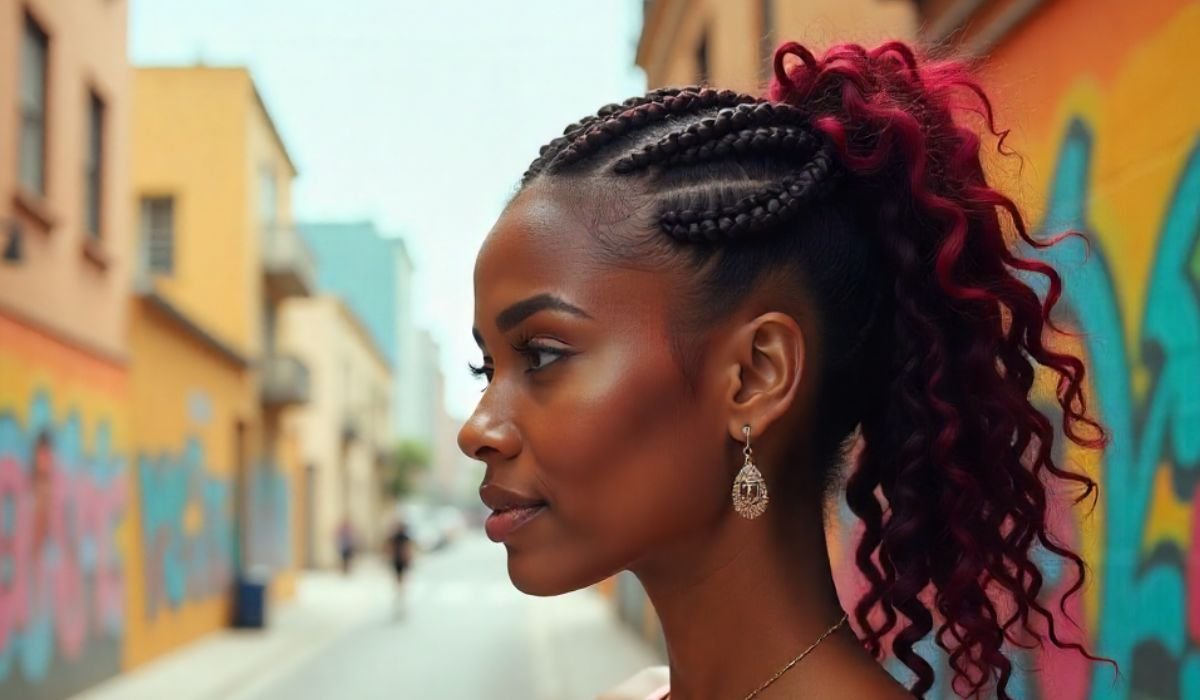Ever found yourself scrolling through Instagram, utterly captivated by a hairstyle that’s both effortlessly cool and intricately detailed? You know the one—it looks like thick, textured rope twists, full of volume and personality. You’ve probably wondered, “What is that style, and could I ever pull it off?”
Well, my friend, you’ve just stumbled upon the world of the Cuban twist. It’s a look that’s been turning heads for decades, and for good reason. It’s the perfect blend of edgy and chic, and it’s one of the most versatile protective styles out there. Whether you’re a natural hair newbie or a seasoned stylist, this guide is your backstage pass to everything you need to know.
So, What Exactly is a Cuban Twist?
Let’s start with the basics. Imagine a Havana twist or a Senegalese twist, but with a distinct, chunkier personality. The Cuban twist is a type of protective hairstyle created by twisting two strands of hair—usually synthetic kanekalon or marley hair—together to form a single, dense, and rope-like braid.
What sets it apart is its unique texture and size. Unlike the super-smooth finish of some twists, Cuban twists have a slightly rougher, more textured feel. They’re not thin or delicate; they’re bold, substantial, and make a statement. They’re the confident, older cousin of the standard twist, and they carry themselves with a certain flair.
Key Characteristics:
- Chunky & Textured: They are known for their substantial gauge and a matte, almost wool-like finish.
- Versatile Styling: You can wear them down, in a high ponytail, a bun, or even half-up, half-down.
- A True Protective Style: By completely covering your natural hair, they shield it from daily manipulation, heat, and environmental damage, allowing it to rest and grow.
Why You’ll Fall in Love With This Style: The Top Benefits
So, why choose a Cuban twist over the countless other options? The benefits are seriously impressive.
- Ultimate Hair Protection: This is the biggest win. For 4-6 weeks (sometimes longer with good care!), your natural hair is tucked away safely from breakage, tangles, and the stresses of styling.
- Low-Maintenance Glamour: Once installed, your morning routine becomes a breeze. A little moisturizing spray, some oil on your scalp, and you’re out the door looking put-together.
- Volume and Versatility for Days: The thickness of these twists gives you instant volume. They are a dream to style, offering endless possibilities to match any outfit or occasion.
- A Confidence Booster: There’s something incredibly empowering about a hairstyle that is both culturally rooted and fashion-forward. It’s a look that commands attention in the best way possible.
Your Pre-Twist Checklist: Gathering Your Supplies
Before you book that salon appointment or set up your at-home styling station, you’ll need to gather your tools. Think of it like prepping for a craft project with a fabulous outcome.
You Will Need:
- Hair Extensions: Kanekalon hair is the most popular choice. It’s lightweight, heat-friendly, and blends seamlessly. For a more authentic, coarser texture, Marley hair is a great alternative.
- A Good Leave-In Conditioner: To moisturize your hair before it goes into hiding.
- Rat-Tail Comb: For precise parting.
- Hair Clips: To section your hair as you work.
- Styling Gel or Edge Control: For sleek, polished edges and parts.
- Scissors: For trimming the hair and finishing the ends.
- Hair Oil (like Jojoba or Almond): For keeping your scalp happy and hydrated.
- A Spray Bottle with Water: For managing frizz and keeping the hair pliable.
The Main Event: How Cuban Twists Are Installed
While I always recommend a professional for the cleanest, longest-lasting install, understanding the process is super helpful. Here’s a simplified, step-by-step breakdown.
Step 1: The All-Important Prep Work
This is non-negotiable. Your natural hair must be freshly washed, deep-conditioned, and thoroughly detangled. Start on a clean, healthy slate. Many stylists then braid or twist the natural hair into cornrows as a base, which provides a strong anchor for the synthetic hair.
Step 2: Parting is Such Sweet Sorrow
Using your rat-tail comb, create neat, clean parts. The size of your parts will determine the size of your twists. Larger parts mean chunkier, fewer twists; smaller parts mean more, thinner twists.
Step 3: The Twisting Technique
This is where the magic happens.
- Take a section of your pre-braided base or natural hair and a strand of synthetic hair.
- Split the synthetic hair into two equal sections.
- Now, simply begin twisting the two synthetic strands around each other, incorporating your natural hair at the root. It’s like you’re creating a rope, but you’re wrapping the fibers tightly together.
- Continue twisting all the way down to the ends.
Step 4: Sealing the Deal
To prevent the twists from unraveling, you need to seal the ends. The most common method is using a lighter to carefully melt the synthetic fibers together. Please be extremely cautious if you do this at home! A safer alternative is dipping the ends in hot, almost-boiling water.
Keeping Your Twists Looking Fresh: A Maintenance Guide
Your work isn’t over once they’re in! Proper care is what separates a good install from a great one that lasts.
- Moisturize, Moisturize, Moisturize: Spray a light leave-in conditioner or a water-based moisturizer on your twists every few days to keep them from looking dry.
- Pamper Your Scalp: Gently apply oil to your scalp with a nozzle-tip bottle every week to prevent itching and flakiness.
- The Nighttime Ritual: Always, always protect your style at night. Sleep on a satin or silk pillowcase, or wrap your hair in a satin scarf or bonnet. This reduces friction and frizz dramatically.
- Washing? Yes, You Can! You can and should wash your scalp. Mix a diluted shampoo in an applicator bottle, gently massage your scalp, and rinse. Follow up with a light conditioner. Let your hair air dry completely—this might take a day or two.
Cuban Twists vs. Other Popular Twists: A Quick Comparison
| Feature | Cuban Twists | Senegalese Twists | Havana Twists |
| Texture | Coarse, matte, rope-like | Smooth, silky, defined | Very coarse, thick, bulkier |
| Size | Chunky to Medium | Often Medium to Thin | Very Chunky |
| Hair Used | Kanekalon or Marley | Kanekalon | Marley Hair |
| Overall Look | Bold, textured, urban | Sleek, elegant, versatile | Ultra-voluminous, statement-making |
Troubleshooting Common Questions (FAQs)
Q: How long do Cuban twists typically last?
A: With proper care, you can expect them to last between 4 to 8 weeks. Any longer and you risk matting and potential damage to your natural hair underneath.
Q: Can I install Cuban twists on short hair?
A: Absolutely! Yes, here’s how: your stylist will use the cornrow base method to securely attach the extensions to your shorter natural hair.
Q: Are they heavy on the scalp?
A: They can have some weight due to the density of the hair, but a proper install with a good braided base distributes the weight evenly. If you have a sensitive scalp, opt for a medium-sized twist instead of an extra-chunky one.
Q: What’s the best way to take them out?
A: Patience is key! Use a pair of sharp scissors to carefully cut the synthetic hair a few inches from your root. Then, gently unravel the twist. Never rip or pull them out. Follow up with a thorough wash and deep conditioning treatment for your natural hair.
Wrapping It Up: Your 3-Step Action Plan
So, are you ready to rock this incredible style? Here’s your simple action plan:
- Do Your Research: Look for inspiration photos and find a skilled stylist in your area who specializes in protective styles. Read reviews and look at their portfolio!
- Invest in Quality: Don’t skimp on the hair extensions or your pre-care products. Your hair’s health is worth it.
- Commit to the Care: Plan your maintenance routine before you get them installed. Having your satin bonnet and moisturizing sprays ready will ensure your style stays gorgeous for weeks.
The Cuban twist is more than just a hairstyle; it’s a celebration of texture, volume, and cultural beauty. It’s a testament to the fact that protecting your hair doesn’t mean sacrificing style. In fact, it can be the start of your most stylish chapter yet.
Have you tried Cuban twists before? What was your experience? Share your tips and stories in the comments below—I’d love to hear from you!
FAQs
Q1: How much does a Cuban twist install usually cost?
The cost can vary widely based on your location, the stylist’s expertise, and the length and thickness of the twists. Generally, you can expect to pay anywhere from $150 to $400+.
Q2: Can I color Cuban twist hair?
Yes! Kanekalon hair takes very well to hair dye. You can use permanent or semi-permanent color to create gorgeous ombres, dip-dyes, or even completely change the color of your twists.
Q3: Will this style damage my edges?
A proper, not-too-tight install should not damage your edges. However, if the twists are installed with too much tension or kept in for too long, they can cause stress and traction alopecia. Always communicate with your stylist about tension and take them out if you feel persistent pain.
Q4: What’s the best way to style Cuban twists?
The possibilities are endless! Try a high ponytail, a top knot, a side-swept style, or accessorize with stylish wraps, beads, or rings for a personalized touch.
Q5: How many packs of hair do I need for a full head?
For a full head of medium-sized Cuban twists, you will typically need between 6 to 8 packs of kanekalon hair. For chunkier twists, you might use 5-6, and for thinner ones, 8-10.
Q6: Is it okay to workout with Cuban twists?
Absolutely. They are a great style for an active lifestyle. Just be sure to gently wash your scalp after heavy sweating to prevent product and sweat buildup.Q7: My twists are looking frizzy. What can I do?
A little frizz is normal and adds to the texture! For excessive frizz, you can use a light-hold gel or edge control on a small toothbrush to smooth down the flyaways, or briefly pass a low-heat steam or blow dryer over them.

